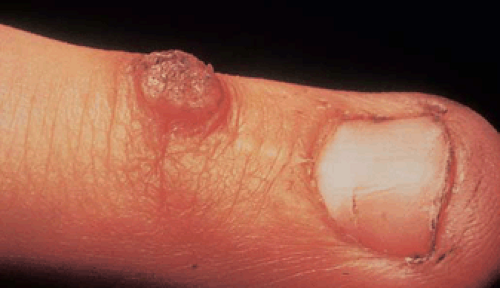Warts
John T. Crissey
(ICD-9 078.1)
Symptoms and Signs
Warts are generally asymptomatic. They are caused by human papilloma virus (HPV) infections of the skin and mucocutaneous surfaces. All lesions are potential sources of infection. They appear in several different forms.
Verruca Vulgaris
Verruca vulgaris is the common wart that usually occurs on the hands, fingers, wrists, and forearms of children and young adults. Nail folds are often involved. No area is immune to infection. The lesions are asymptomatic, flat or dome-shaped papules, 2 to 10 mm in diameter (Fig. 59-1). They may run together to form still larger lesions. Early verrucae are usually smooth. Mature lesions are rough; the surface becomes covered with tiny keratotic projections. Warts may be skin-colored, yellowish, brown, or dark gray. They sometimes occur in linear configurations, the virus having been inoculated in a scratch “like planting a row of potatoes” (Koebner’s phenomenon).
Verruca Plantaris (Plantar Warts)
Unlike other verrucae, plantar lesions are often tender and sometimes painful. They usually appear at the pressure points on the sole, where callus formation often obscures the true nature of the lesion. Trimming the callus reveals a whitish sodden circle studded with dark red or black dots (thrombotic capillaries), a sign that is virtually diagnostic. Larger lesions may also show evidence of pressure-induced intralesional hemorrhage. Multiple plantar verrucae may run together to produce mosaic-like patterns, sometimes involving almost the entire sole.
 Figure 59-2 Verruca plana. Smooth, brown, flattened papules are often on the face.
Stay updated, free articles. Join our Telegram channel
Full access? Get Clinical Tree
 Get Clinical Tree app for offline access
Get Clinical Tree app for offline access

|






